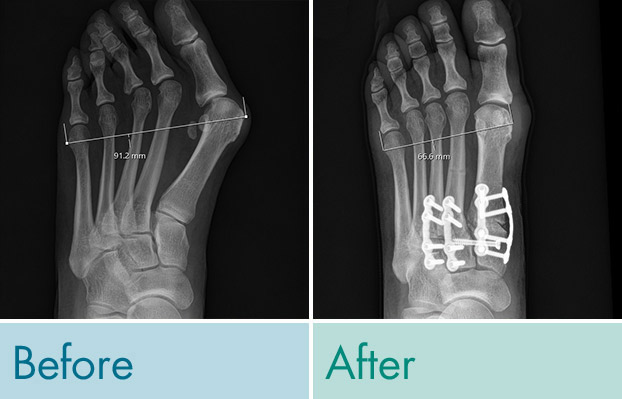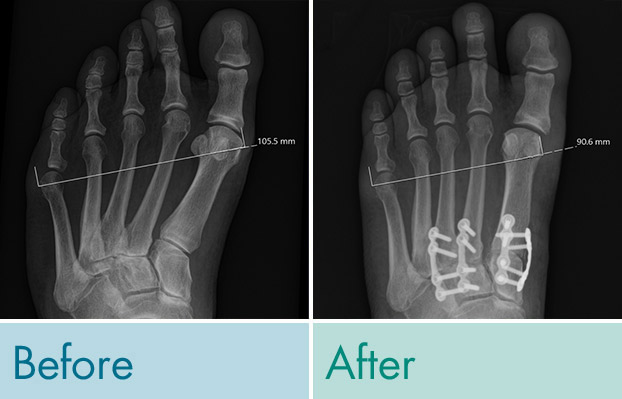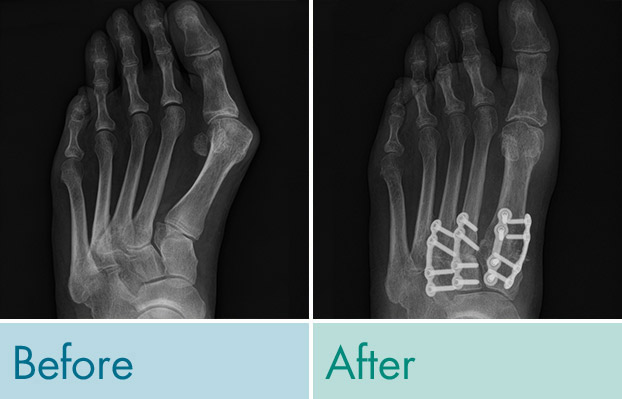
Metatarsus Adductus – Adductoplasty™ 3D Correction
The Condition
‘Metatarsus Adductus’ (MTA) deformity of the foot affects approximately 30-35% of patients with symptomatic hallux valgus; also known as bunions. This compound pathology increases the risk for deformity recurrence in 30% of cases if not managed properly from a surgical perspective. Patients that have this foot deformity are born with the problem and it does not spontaneously resolve with age or growth. The deformity becomes rigid and fixed as patients reach skeletal maturity. The long bones of the foot called the metatarsals are all deviated toward the midline of the body.
Patients with MTA appear to have severe bunions with a deviation and painful crowding of the great toe and lesser toes. Fitting shoes can also be very difficult due to a mismatch in foot width. Patients tend to have a very wide forefoot and a narrow hindfoot. The prominence of the big toe joint becomes impinged when wearing shoes. This creates a source of frequent irritation and pain that can ultimately result in nerve injury, limitation in motion, and joint arthritis.
The Treatment
The systematic approach to the surgical correction of combined hallux valgus and metatarsus adductus deformities provides the benefit of a standard reproducible surgical approach that achieves tri-planar correction at multiple joints to fully correct the compound deformity. This technique supports early weight bearing for mild, moderate and severe deformities.
This surgical technique was first described and published in the Journal of Foot and Ankle Surgery by Dr. JP McAleer and his co-authors. It makes use of specialized instrumentation he and his colleagues specifically designed to cut, manipulate and reduce the lesser tarsal metatarsal joint deformities prior to addressing the bunion via Lapiplasty® 3D Bunion Correction. This technique provides patients the benefits of a reproducible approach that facilitates the use of locking plate technology to maintain the correction at multiple levels. In our experience patients have a narrowing of the forefoot which improves foot proportions and may improve shoe wear and comfort.
JCMG Podiatry is the first facility in the State of Missouri to offer this surgical approach and its surgeons are among the most experienced in the nation. Our expert team actively educates surgeons nationally at multiple events annually on this and other techniques.
Frequently Asked Questions
Before & After Photos
Patient Education
*Warning – graphic surgical content* Watch Dr. McAleer perform the novel Adductoplasty™ Three-Dimensional Midfoot Deformity Correction procedure.
Metatarsus Adductus in the News
A Systematic Approach to the Surgical Correction of Combined Hallux Valgus and Metatarsus Adductus DeformitiesThis article describes the standardized reproducible surgical technique that Dr. McAleer and his colleagues recently published in the Journal of Foot and Ankle Surgery for the treatment of this complex foot deformity.
Impact of Metatarsus Adductus on HAV RepairListen as Dr. McAleer and a round table of experts from the American College of Foot and Ankle Surgeons discuss current trends and treatments for Metatarsus Adductus and Hallux Valgus.
Metatarsus Adductus: Keys To Patient Assessment And Surgical Decision-MakingReportedly one-third of patients with hallux valgus have concomitant metatarsus adductus. In the first of a two-part podcast, Drs. Duke and McAleer discuss the potential progression of untreated metatarsus adductus into a rigid deformity in adulthood, anatomical considerations with incision placement and a stepwise approach to intraoperative decision-making.
Essential Aspects To Treating Metatarsus AdductusIn the second part of a two-part podcast, Drs. Duke and McAleer discuss the role of metatarsus adductus in first ray pathology, share post-op protocol principles and emphasize the importance of examining the impact of the deformity beyond the first ray.
Addressing Metatarsus Adductus in the Adult PatientIn this article for Podiatry Today, Dr. McAleer describes how patients with metatarsus adductus require careful clinical and radiographic analysis before considering surgery for hallux valgus or other concomitant pathology like tarsometatarsal osteorathritis, metatarsal parabola issues or skew foot.



